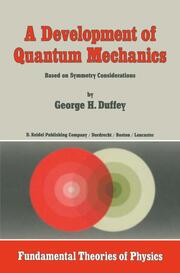Detailansicht
A Development of Quantum Mechanics
Based on Symmetry Considerations, Fundamental Theories of Physics 2
ISBN/EAN: 9789401088008
Umbreit-Nr.: 5649273
Sprache:
Englisch
Umfang: 356 S.
Format in cm:
Einband:
kartoniertes Buch
Erschienen am 26.09.2011
Auflage: 1/2011
- Zusatztext
- The theory of quantum mechanics continues to appear arbitrary and abstruse to new students; and to many veterans, it has become acceptable and useable only because it is familiar. Yet, this theory is at the basis of all modern physics, chem istry, and engineering, describing, as it does, the behavior of the submicroscopic particles making up all matter. So it needs to be presented more effectively to a diverse audience. The primary question is, I believe, 'What can be considered self-evident?' Indeed, what do certain key experiments reveal about the workings of nature? How can we consider that some probabilities are not a result of our ignorance, but instead, fundamental properties? We must pay particular attention to the subject of what we can do, what we cannot do, and what we can and cannot observe. We can prepare a homogeneous beam of almost independent particles by boiling electrons out of a metal and accelerating them by a given potential drop. We cannot follow an electron in dividually in the beam without introducing conditions that destroy the beam's homogeneity, but we can detennine when electrons arrive at a given position.
- Autorenportrait
- Inhaltsangabe1 / Quantization of Translatory Motion.- 1.1. Background Remarks on Time and Space.- 1.2. The Statistical Nature of Position, Velocity, and Momentum.- 1.3. A State Function Governing Translation.- 1.4. Diffraction by Neighboring Parallel Slits.- 1.5. Diffraction by Molecules.- 1.6. Dependence of the Function for a Definite Energy State on Time.- 1.7. Independent Movements within a State.- 1.8. The Continuum of Translational States.- 1.9. Periodic, Rectangularly Symmetric, Free Motion.- 1.10. Enumerating and Filling Translational States.- 1.11. Translational Energy of an Ideal Gas.- 1.12. Standing-Wave Translational Functions.- 1.13. Confined Rectangularly Symmetric Motion.- 1.14. Attenuated Motion.- 1.15. Joining Regions of Differing Potentials 3.- Discussion Questions.- Problems.- References.- 2 / Quantization of Rotatory Motion.- 2.1. Separation of Different Modes of Motion from Each Other.- 2.2. One-Particle Model for a Linear Rotator.- 2.3. Variation of ? in a Spherically Symmetric Field.- 2.4. The Rotational State Described by the Traveling Wave.- 2.5. Quantization of the Simple Rotator.- 2.6. Standing-Wave Rotational Functions.- 2.7. Energy Levels for a Two-Dimensional Rotator.- 2.8. Rotational Spectrum of a Linear Molecule.- 2.9. Broadening of Spectral Lines.- 2.10. Angular Momenta and the Resultant Energies for a Nonlinear Rotator.- 2.11. Quantizations of Prolate and Oblate Rotators.- 2.12. The Asymmetric Rotator.- 2.13. Dependence of ? on ? in a Spherically Symmetric Field.- 2.14. Explicit State Functions for Angular Motion in a Central Field.- Discussion Questions.- Problems.- References.- 3 / Quantization of Vibratory Motion.- 3.1. Additional Concerted Movements.- 3.2. Vibrational Kinetic and Potential Energies for a Diatomic Molecule.- 3.3. Derivatives of the State Function in Regions where the Potential Energy is not Constant.- 3.4. The Schrödinger Equation for Simple Harmonic Motion.- 3.5. Suitable State Functions for the Harmonic Oscillator.- 3.6. Properties of the Harmonic Oscillator ?v's.- 3.7. Transitions between Vibrational Energy Levels.- 3.8. Vibrational Spectrum of a Diatomic Molecule.- 3.9. Anharmonicities and their Net Effects.- 3.10. Spectra of Polyatomic Molecules.- 3.11. Raman Spectra.- 3.12. The State Sum for a Vibrational Mode.- 3.13. Operator Formulations of the Harmonic Oscillator Equation.- Discussion Questions.- Problems.- References.- 4 / Radial Motion in a Coulombic Field.- 4.1. A More Complicated Oscillation.- 4.2. Representing the Axial and Angular Motions of Two Particles Bound Together.- 4.3. Differential Equations Governing Variations in a State Function.- 4.4. An Orthogonal-Coordinate Representation of ?2.- 4.5. Separating the Radial Variable from the Angular Variables in the Schrödinger Equation.- 4.6. The Radial Equation for an Electron - Nucleus System.- 4.7. Laguerre Polynomials.- 4.8. Quantization of the Radial Motion.- 4.9. Electronic Spectrum of a Hydrogen-like Atom or Ion.- 4.10. Uninuclear Multi-electron Structures.- 4.11. Useful Operator Formulations of the Radial Equation.- Discussion Questions.- Problems.- References.- 5 / Quantum Mechanical Operators.- 5.1. Dependence of Observables on the State Function.- 5.2. Eigenvalue Equations.- 5.3. Formula for the Expectation Value.- 5.4. The Dirac Delta.- 5.5. Operators for Momenta and Energy.- 5.6. The Hamiltonian Operator.- 5.7. Shift Operators for the Harmonic Oscillator.- 5.8. Nodeless Solutions.- 5.9. Acceptable Wavy Solutions.- 5.10. The Inverse Operator as the Adjoint of an Operator.- 5.11. Shift Operators for a Hydrogen-like Atom.- 5.12. Spontaneous Decay of an Unstable State.- Discussion Questions.- Problems.- References.- 6 / Wave Packets, Potentials, and Forces.- 6.1. Mixing Wave Functions.- 6.2. Fourier Series and Fourier Integrals.- 6.3. Broadening of a Level Caused by Instability.- 6.4. A Gaussian Wave Packet and its Wavevector Representation.- 6.5. An Arbitrary Superposition of Simple Planar Waves.- 6.6. The De Brogli
